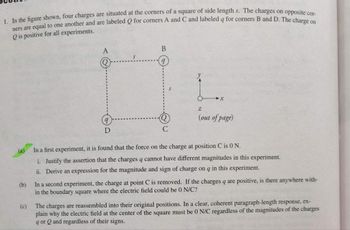Question
Hi, can you help me with this question a, b, c, please?
I am having a hard time with these questions.....
thanks a lot!
fast pls i will give u thumsup

Transcribed Image Text:1. In the figure shown, four charges are situated at the corners of a square of side length s. The charges on opposite cor-
ners are equal to one another and are labeled Q for corners A and C and labeled q for corners B and D. The charge on
Qis positive for all experiments.
A
D
B
Z
(out of page)
(a)
In a first experiment, it is found that the force on the charge at position C is 0 N.
i. Justify the assertion that the charges q cannot have different magnitudes in this
ii. Derive an expression for the magnitude and sign of charge on q in this experiment.
eriment.
(b)
In a second experiment, the charge at point C is removed. If the charges q are positive, is there anywhere with-
in the boundary square where the electric field could be 0 N/C?
(c)
The charges are reassembled into their original positions. In a clear, coherent paragraph-length response, ex-
plain why the electric field at the center of the square must be 0 N/C regardless of the magnitudes of the charges
9 or Q and regardless of their signs.
Expert Solution
This question has been solved!
Explore an expertly crafted, step-by-step solution for a thorough understanding of key concepts.
This is a popular solution
Trending nowThis is a popular solution!
Step by stepSolved in 5 steps with 5 images
